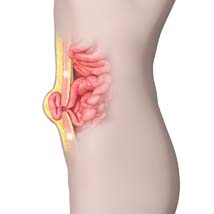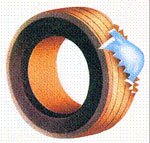Hernia

What are hernias all about?
A hernia is an opening or weakness in the abdominal wall. The abdominal wall is made up of muscle layers and if these layers weaken the abdominal contents and their lining can protrude through the wall causing a bulge. This bulge is made up of the abdominal lining (peritoneum), tissue, or organ membrane that normally holds an organ in place. Hernias occur more frequently in certain parts of the body such as the abdominal wall, groin, upper thigh (femoral), and belly button region. They can also occur in any place where you have had an incision from previous surgery.

Picture an old tyre. Its outer wall is like the layers of tissue surrounding your abdomen, (the "abdominal wall"). The tyre's inner tune is like the thin lining of your abdomen the "peritoneum"). Instead of holding air, your abdomen holds the intestines and other vital organs. Most often, the outer wall is strong enough to keep these organs in place. But if the wall gets weak, a hernia may form.

Just as a bulge can form in a worn tyre, a Hernia may form in a weak abdominal wall. At the weak spot, a hernia sac. (bulging abdominal lining), may fill with intestine or fat. This often causes some pain. Prompt surgery is often advised because hernias won't go away by themselves. If the intestine becomes trapped in the hernia, serious intestinal and digestive problems can occur:
How do I get hernia?
Hernias can be present at birth or occur over time due to stress and strain on the abdominal wall. Most hernias become apparent later in life because it takes time for the hernial sac to enlarge enough for tissue to fall into it.
Types of Hernia

Inguinal Hernia - These are the most common type of hernias and there are two main types of Inguinal Hernias. They are called Direct and Indirect hernias. These hernias can appear as a bulge in the groin or protrude into the top of the scrotum depending on the exact type and size of hernia that is present.
A Direct Inguinal Hernia is a protrusion of abdominal contents and it's lining (peritoneum) through the lower abdominal wall.
An Indirect Inguinal Hernia is a protrusion of abdominal contents and it's lining (peritoneum) through the inguinal canal. The Inguinal canal is a series of small openings like a passage way, through the layers of the abdominal wall in the groin, which the blood supply and vas deferens for the testicles in the male travel. In the female, the round ligament of the uterus is the only structure that travels through the inguinal canal. The inguinal canal is recognized as one of the several weak points in the abdominal wall where a hernia could develop. Inguinal hernias are more common in men than women.
Femoral Hernia - This type of groin hernia can appear as a bulge in the upper thigh. A femoral hernia is a loop of intestine, or another part of the abdominal contents, that has been forced out of the abdomen through a channel called the "femoral canal" - a tube-shaped passage at the top and front of the thigh. This type of hernia tends to occur in older people and is more common in women than in men.
Incisional Hernia - Is a Hernia that has formed through an incision (scar) from previous abdominal surgery that a patient has undergone.
Umbilical Hernia - Umbilical hernia is a small bulge around the umbilicus (belly button). An umbilical hernia in an infant is caused by the incomplete closure of the muscles around the umbilicus.
Hiatus Hernia - Normally, the stomach is completely below the diaphragm. A hiatus hernia is when part of the stomach slides through the diaphragm, the muscular sheet that separates the lungs and chest from the abdomen.
Risk Factors
Risk Factors for Hernias in general include:
- Family history of hernias
- Overweight or Obesity
- Undescended testes in an infant male
- Any condition that increases the abdominal pressure is a potential risk factor for abdominal hernias. Some examples include: chronic coughing, chronic constipation, enlarged prostate causing straining with urination, and carrying or pushing heavy loads at work or sport for instance.
Why should hernias be repaired?
Once a hernia has developed it will tend to enlarge and cause discomfort. If a loop of bowel gets caught in the hernia it may become obstructed or its blood supply may be cut off. This could then become a life-threatening situation. Since hernias can be repaired effectively and with minimal risk most surgeons therefore recommend that hernias be repaired when diagnosed unless there are other serious medical problems.
What are my options?
Wearing a truss or binder may temporarily alleviate symptoms but will not cure the hernia. Only surgery corrects the defect in the belly wall.
Traditional repair techniques involve pulling together muscles and ligaments for reinforcement. Since muscles are soft and movable, while ligaments remain rigid and stationary, these structures can separate over time causing hernia recurrence.
In fact, approximately small percentage of hernias do recur. In the Inguinal region for example this may happen in 1% of cases.
How are hernias repaired?
The standard method of hernia repair involves making an incision in the abdominal wall. Normal healthy tissues are cut until the area of weakness is found. The hernia sac is excised or reduced back into its normal position. A prosthetic mesh made from prolene or polyester is used to strengthen the area of weakness. Finally the skin and other healthy tissues that were cut at the beginning are stitched back together to complete the repair.
How does the laparoscopic method differ?
With the laparoscopic repair the defect in the abdominal wall is repaired from the inside of the abdominal cavity. This method is used for groin as well as all the other types of hernia. Instead of closing or patching the repair from the outside the patch is secured in place from the inside. This eliminates the necessity of cutting the skin and normal tissues of the groin to get down to and repair the hernia. Nerve damage and chronic pain are reduced and in general return to normal activities is accelerated.
